On Mars, satisfaction awaits Curiosity rover
Editor's note: The following story was written for CNET and is reposted here with permission. Pictures have been updated to reflect current planning and progress.
By WILLIAM HARWOOD
CBS News
KENNEDY SPACE CENTER, FL--Under the watchful eyes of anxious engineers, NASA's $2.4 billion Mars Science Laboratory rover has taken its first baby steps, rolling a few feet forward and back in an environmentally controlled clean room.
It was a seemingly modest test for an unfinished spacecraft that still faces technical challenges and months of assembly and testing. But with landing on the Red Planet now just two years away, the short drive on July 23 marked a major milestone for the men and women building the car-size rover.
"It's gone from designs on napkins to PowerPoint, to CAD drawings, to blueprints, and now it's a rover," Ashwin Vasavada, deputy project scientist, said in a NASA interview. "This is really one of the big milestones...It sort of blows your mind to look at this thing and see something that's going to be on Mars one day."
Dubbed "Curiosity" in a student naming contest, the one-ton rover is two years behind schedule. NASA managers opted to pass up a 2009 launch window to resolve vexing technical issues, a decision that added nearly $500 million to the project's price tag.
But engineers say that the time and money were well spent and that Curiosity is on track for takeoff during the next Mars launch window in late 2011.
Its nuclear power pack will not be installed until shortly before launch, but its six individually motorized wheels and camera mast were attached earlier in July, and its 10 science instruments are in final assembly and checkout.
"I don't see any insurmountable hardware problems at this point, they're moving nicely," Doug McCuistion, director of the Mars Exploration Program at NASA Headquarters in Washington, said in an interview with CNET. "The last few instruments are still being delivered and I think things are going quite well."
MSL is one of the most expensive planetary missions to date and by far the most complex robotic lander ever built, dwarfing the hugely successful Mars Exploration Rovers Spirit and Opportunity in both size and scientific capability.
Along with pushing the frontiers of science on Mars, the mission also could pay dividends for future manned and unmanned missions.
"I think this is the most important mission the Mars program has ever flown since Viking [in the mid-1970s]," McCuistion said. "This has the potential to not only revolutionize our scientific understanding of the planet, but it also has the potential to change our engineering capabilities for planetary exploration, even beyond Mars."
He was referring to Curiosity's ability to make what amounts to a pinpoint landing using a computer-guided entry and a rocket-powered "sky crane" descent stage above the rover that will slowly lower it directly to the surface on the end of a long bridle.
Using a power source--radioactive decay from plutonium--that makes the rover immune to changing sunlight levels, Curiosity can target landing sites 45 degrees to either side of the equator and set down at higher altitudes. The solar-powered Spirit and Opportunity, both of which arrived on Mars in 2004, were limited to low-altitude sites across a 25-degree equatorial spread.
"This technique is very different--guided entry and sky crane," McCuistion said. "It sets the stage for large masses to the surface for the first time, which means we can put a lot of things down we wouldn't have dreamed of putting down over the last 20 years.
"So it is a major step forward, it's a quantum leap instead of an incremental step. Scientifically, I anticipate this will push us from a 'follow the water' strategy to...a 'seeking the signs of life' strategy. I really think it's going to change our focus."
NASA's twin Viking landers touched down on Mars in 1976, photographing their landing sites in unprecedented detail, studying the Martian weather and carrying out sophisticated experiments to look for signs of biological activity. No clear evidence was found and NASA later shifted its emphasis to understanding the role water played in the evolution of the Martian environment.
Thanks to the Mars Pathfinder, Spirit, Opportunity, and the Phoenix polar lander, along with a half-dozen orbiting spacecraft, NASA's follow-the-water strategy paid off. Scientists now know that Mars once enjoyed a warmer, much wetter climate in the distant past, including what may have been a huge ocean in the northern hemisphere.
The question now is whether organic compounds--the building blocks of life as it is known on Earth--were present and whether any habitable environments emerged and persisted long enough for life to evolve.
Curiosity's instruments will look for carbon compounds and features in the Martian environment that might represent the results of biological processes. The rover also will study the chemistry and composition of rocks and soil in the landing zone, assess weather patterns, measure the radiation environment, and determine the long-term distribution of water and carbon dioxide.
"What we're trying to do with Mars Science Laboratory is to explore potentially habitable environments, both in the modern environment of Mars as well as the ancient environment," project scientist John Grotzinger said in an interview.
But first, Curiosity has to make it to the surface.
'Six minutes of terror'
The giant airbags that cushioned the descents of NASA's Mars Pathfinder, Spirit, and Opportunity rovers cannot be used for spacecraft as large as MSL. And using a more traditional rocket-powered, legged lander like Phoenix or the Viking spacecraft poses its own set of problems, including the unavoidable hazard of driving a large rover off an elevated, possibly tilted lander.
The sky crane avoids those technical difficulties, putting the descent stage above the rover and using a relatively simple gravity-fed tether mechanism to lower it directly to the surface. Like a helicopter lowering equipment on a winch, Curiosity will be set down on its wheels and ready to drive.
It's an innovative solution to a significant engineering challenge. But the sky crane cannot be fully tested in Earth's much stronger gravity. Only half in jest, engineers refer to MSL's descent to the surface as "six minutes of terror."
"Unfortunately, a lot can go wrong and it forces you to live a life of some sort of strange paranoia," said Adam Steltzner, EDL project development manager at JPL. "If you think about the number of lines of code, the number of circuit elements, number of mechanical fixtures and devices, it actually is completely terrifying."
But Steltzner and MSL Project Manager Pete Theisinger said exhaustive testing and analysis give the team high confidence the sky crane system will work as planned to gently lower Curiosity to the cold surface of Mars.
"The project early on engaged in an awful lot of reviews--internal, external, headquarters reviews--to really establish the design of the sky crane was solid," Theisinger said. "And the support equipment that's been required for it, the radar, the valves for the throttle-able engines, all the things that are required to support EDL, their performance has been as good or better than expected."
MSL is scheduled for launch from the Cape Canaveral Air Force Station atop a United Launch Alliance Atlas 5 rocket between November 25 and December 18, 2011. After a nine-month cruise, the spacecraft will make a direct descent to the Martian surface between August 6 and August 20, 2012.
Teams of scientists currently are studying four possible landing sites, all of them prime candidates for harboring clues about the past and present habitability of Mars.
The exact timing of MSL's arrival will depend on which site is selected and when NASA's Mars Odyssey and Mars Reconnaissance Orbiter satellites will be passing over to relay telemetry back to Earth. Odyssey can relay data as it is received, while the Mars Reconnaissance Orbiter will store the telemetry and play it back one orbit later.
The MSL lander can beam data directly back to Earth on its own at up to 32,000 bits per second, about half as fast as a typical modem. But it can be much slower than that, and at least two of the proposed landing sites will be out of direct line-of-site to Earth. For the dramatic landing phase, engineers will rely on satellite relay.
What Curiosity is packing
Once on the surface and in day-to-day operation, Curiosity will send telemetry directly to Earth when required and via high-speed links through Odyssey and MRO when available.
"It's the most complex payload that's ever been flown to the surface of another planet," said Grotzinger. "That gives us the ability to do very in-depth and detailed evaluation of the composition of the atmosphere, how fast the wind blows, what the atmospheric pressure is, what are the daily temperatures, max and min?
"And in addition to that, we have all the instruments that will take images of the surface of all the geological features. Then we've got a whole bunch of analytical instruments that will give us information on the composition of rocks and soils. We'll be able to utilize that data to look specifically at whether or not these ancient environments, some of which could be 4 billion years old, would have been the kind of environments that [could have supported] life."
Curiosity tips the scales more than 1,950 pounds, versus 375 pounds for Spirit and Opportunity. It features a mast carrying cameras and instruments, including a laser to vaporize material from nearby rocks, and a robot arm capable of grinding and cleaning rocks and scooping up samples for detailed chemical analysis.
Unlike Spirit and Opportunity, which relied on solar panels for power, MSL will be powered by a radioisotope thermoelectric generator, or RTG, that uses thermocouples to convert the heat of radioactive decay into electricity. That same heat also will be used to keep the spacecraft's sensitive systems warm in the frigid Martian environment.
Spirit and Opportunity, which had to power down at night and during the long Martian winter, were certified for only three months of surface operations. They have now been in operation for six years, but their activity is governed by the sun (Spirit is currently in hibernation and has not phoned home since March 22).
The Mars Science Laboratory is an all-weather vehicle designed to operate for a full Martian year--equal to two Earth years--and to rove at least 12 miles.
"For our rover this time around, it is minimally supposed to go 20 kilometers," said Grotzinger. "Remember, the MER rovers [Spirit and Opportunity] were supposed to go 300 meters. They obviously went well beyond that...We've got to make sure we can deliver what people think we're actually promising."
NASA originally hoped to launch the Mars Science Laboratory in 2009. But on December 4, 2008, then-Administrator Mike Griffin, McCuistion and Ed Weiler, NASA's associate administrator for science, announced a two-year delay to give engineers more time to test critical components and to resolve problems with electromechanical actuators needed by a wide variety of systems.
When the slip to the next Mars launch window was announced, a top-level analysis indicated the delay would add around $400 million to the cost of the mission. The actuator issue proved more difficult to resolve than first expected. As a result, McCuistion said, the delay could cost as much as $495 million.
"The actuators got a lot of the press at that point in time, but I think it was much more broad than that," Theisinger said. "I think we felt with the delivery delays we'd had in several areas that we just did not have enough time to complete a good-enough test program to be confident that we had all the risk retired by the time we got to the 2009 launch opportunity."
All of the actuators have now been delivered, and qualification units have completed life cycle testing. The steering and motor actuators needed by Curiosity's wheels and suspension are now in place on the spacecraft. Actuators for the rover's instrument/camera mast have been installed in the mast and those needed by Curiosity's robot arm are undergoing environmental testing.
The spacecraft's critical landing radar, which will feed data to the flight computer during powered descent to the surface, should be delivered in late August, after environmental testing. An engineering model has been tested on a helicopter and will be mounted in an F-18 jet in October for additional trials.
The rover's electronics have been "more of a slog," Theisinger said. Environmental tests of the central computer are under way and the electronics that will control the rover's drive motors have been delivered.
Curiosity's 10 instruments are in various stages of assembly and checkout. One of them, the Sample Analysis at Mars, or SAM, instrument features a gas chromatograph, a mass spectrometer, and a tunable laser to identify carbon-containing compounds. Certification of a 100,000-rpm pump has proved especially difficult, and the instrument is not expected to be delivered until the end of the year.
"I think for the most part, all the flight stuff will be in our hands, with the exception of the SAM instrument, around September or October," Theisinger said. "We are currently scheduled to start the environmental testing on the full-up rover in the third week of February of next year. That'll run a couple of months. Then we ship directly to Florida."
By WILLIAM HARWOOD
CBS News
KENNEDY SPACE CENTER, FL--Under the watchful eyes of anxious engineers, NASA's $2.4 billion Mars Science Laboratory rover has taken its first baby steps, rolling a few feet forward and back in an environmentally controlled clean room.
It was a seemingly modest test for an unfinished spacecraft that still faces technical challenges and months of assembly and testing. But with landing on the Red Planet now just two years away, the short drive on July 23 marked a major milestone for the men and women building the car-size rover.
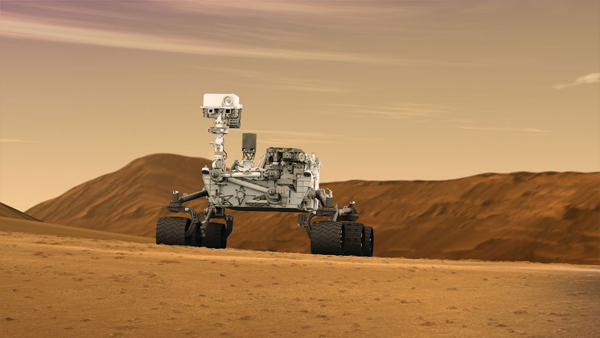 |
| A computer graphic showing NASA's nuclear-powered Mars Science Laboratory rover -- Curiosity -- on the surface of the red planet. (Credit: NASA) |
"It's gone from designs on napkins to PowerPoint, to CAD drawings, to blueprints, and now it's a rover," Ashwin Vasavada, deputy project scientist, said in a NASA interview. "This is really one of the big milestones...It sort of blows your mind to look at this thing and see something that's going to be on Mars one day."
Dubbed "Curiosity" in a student naming contest, the one-ton rover is two years behind schedule. NASA managers opted to pass up a 2009 launch window to resolve vexing technical issues, a decision that added nearly $500 million to the project's price tag.
But engineers say that the time and money were well spent and that Curiosity is on track for takeoff during the next Mars launch window in late 2011.
Its nuclear power pack will not be installed until shortly before launch, but its six individually motorized wheels and camera mast were attached earlier in July, and its 10 science instruments are in final assembly and checkout.
"I don't see any insurmountable hardware problems at this point, they're moving nicely," Doug McCuistion, director of the Mars Exploration Program at NASA Headquarters in Washington, said in an interview with CNET. "The last few instruments are still being delivered and I think things are going quite well."
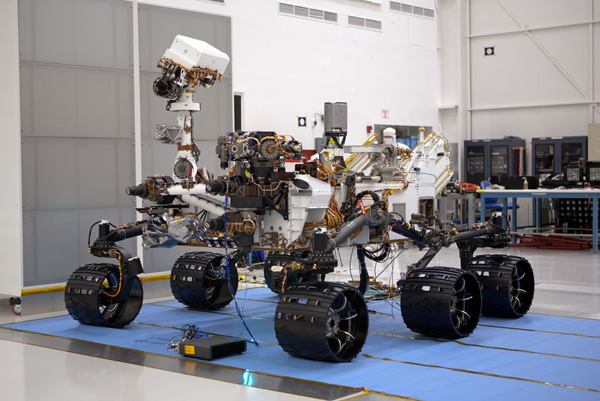 |
| The Curiosity rover during assembly and checkout. (Credit: NASA) |
MSL is one of the most expensive planetary missions to date and by far the most complex robotic lander ever built, dwarfing the hugely successful Mars Exploration Rovers Spirit and Opportunity in both size and scientific capability.
Along with pushing the frontiers of science on Mars, the mission also could pay dividends for future manned and unmanned missions.
"I think this is the most important mission the Mars program has ever flown since Viking [in the mid-1970s]," McCuistion said. "This has the potential to not only revolutionize our scientific understanding of the planet, but it also has the potential to change our engineering capabilities for planetary exploration, even beyond Mars."
He was referring to Curiosity's ability to make what amounts to a pinpoint landing using a computer-guided entry and a rocket-powered "sky crane" descent stage above the rover that will slowly lower it directly to the surface on the end of a long bridle.
Using a power source--radioactive decay from plutonium--that makes the rover immune to changing sunlight levels, Curiosity can target landing sites 45 degrees to either side of the equator and set down at higher altitudes. The solar-powered Spirit and Opportunity, both of which arrived on Mars in 2004, were limited to low-altitude sites across a 25-degree equatorial spread.
"This technique is very different--guided entry and sky crane," McCuistion said. "It sets the stage for large masses to the surface for the first time, which means we can put a lot of things down we wouldn't have dreamed of putting down over the last 20 years.
"So it is a major step forward, it's a quantum leap instead of an incremental step. Scientifically, I anticipate this will push us from a 'follow the water' strategy to...a 'seeking the signs of life' strategy. I really think it's going to change our focus."
 |
| The Curiosity Mars rover and its upper rocket stage during assembly and checkout. (Credit: NASA) |
Thanks to the Mars Pathfinder, Spirit, Opportunity, and the Phoenix polar lander, along with a half-dozen orbiting spacecraft, NASA's follow-the-water strategy paid off. Scientists now know that Mars once enjoyed a warmer, much wetter climate in the distant past, including what may have been a huge ocean in the northern hemisphere.
The question now is whether organic compounds--the building blocks of life as it is known on Earth--were present and whether any habitable environments emerged and persisted long enough for life to evolve.
Curiosity's instruments will look for carbon compounds and features in the Martian environment that might represent the results of biological processes. The rover also will study the chemistry and composition of rocks and soil in the landing zone, assess weather patterns, measure the radiation environment, and determine the long-term distribution of water and carbon dioxide.
"What we're trying to do with Mars Science Laboratory is to explore potentially habitable environments, both in the modern environment of Mars as well as the ancient environment," project scientist John Grotzinger said in an interview.
But first, Curiosity has to make it to the surface.
'Six minutes of terror'
The giant airbags that cushioned the descents of NASA's Mars Pathfinder, Spirit, and Opportunity rovers cannot be used for spacecraft as large as MSL. And using a more traditional rocket-powered, legged lander like Phoenix or the Viking spacecraft poses its own set of problems, including the unavoidable hazard of driving a large rover off an elevated, possibly tilted lander.
The sky crane avoids those technical difficulties, putting the descent stage above the rover and using a relatively simple gravity-fed tether mechanism to lower it directly to the surface. Like a helicopter lowering equipment on a winch, Curiosity will be set down on its wheels and ready to drive.
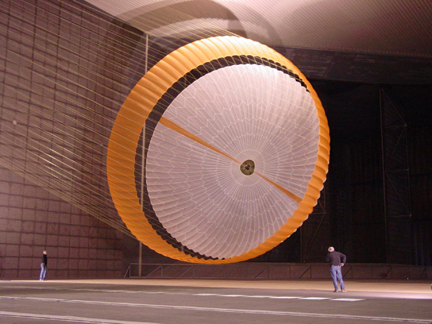 |
| The Mars Science Laboratory braking parachute is tested in a wind tunnel. (Credit: NASA) |
"Unfortunately, a lot can go wrong and it forces you to live a life of some sort of strange paranoia," said Adam Steltzner, EDL project development manager at JPL. "If you think about the number of lines of code, the number of circuit elements, number of mechanical fixtures and devices, it actually is completely terrifying."
But Steltzner and MSL Project Manager Pete Theisinger said exhaustive testing and analysis give the team high confidence the sky crane system will work as planned to gently lower Curiosity to the cold surface of Mars.
"The project early on engaged in an awful lot of reviews--internal, external, headquarters reviews--to really establish the design of the sky crane was solid," Theisinger said. "And the support equipment that's been required for it, the radar, the valves for the throttle-able engines, all the things that are required to support EDL, their performance has been as good or better than expected."
MSL is scheduled for launch from the Cape Canaveral Air Force Station atop a United Launch Alliance Atlas 5 rocket between November 25 and December 18, 2011. After a nine-month cruise, the spacecraft will make a direct descent to the Martian surface between August 6 and August 20, 2012.
Teams of scientists currently are studying four possible landing sites, all of them prime candidates for harboring clues about the past and present habitability of Mars.
The exact timing of MSL's arrival will depend on which site is selected and when NASA's Mars Odyssey and Mars Reconnaissance Orbiter satellites will be passing over to relay telemetry back to Earth. Odyssey can relay data as it is received, while the Mars Reconnaissance Orbiter will store the telemetry and play it back one orbit later.
The MSL lander can beam data directly back to Earth on its own at up to 32,000 bits per second, about half as fast as a typical modem. But it can be much slower than that, and at least two of the proposed landing sites will be out of direct line-of-site to Earth. For the dramatic landing phase, engineers will rely on satellite relay.
What Curiosity is packing
Once on the surface and in day-to-day operation, Curiosity will send telemetry directly to Earth when required and via high-speed links through Odyssey and MRO when available.
"It's the most complex payload that's ever been flown to the surface of another planet," said Grotzinger. "That gives us the ability to do very in-depth and detailed evaluation of the composition of the atmosphere, how fast the wind blows, what the atmospheric pressure is, what are the daily temperatures, max and min?
"And in addition to that, we have all the instruments that will take images of the surface of all the geological features. Then we've got a whole bunch of analytical instruments that will give us information on the composition of rocks and soils. We'll be able to utilize that data to look specifically at whether or not these ancient environments, some of which could be 4 billion years old, would have been the kind of environments that [could have supported] life."
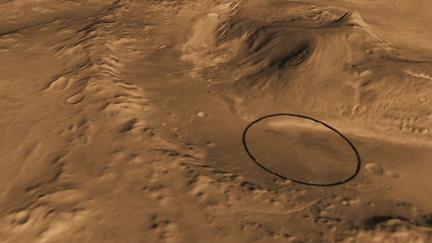 |
| The landing "footprint" in Gale crater where NASA hopes to land the Mars Science Laboratory. (Credit: NASA) |
Unlike Spirit and Opportunity, which relied on solar panels for power, MSL will be powered by a radioisotope thermoelectric generator, or RTG, that uses thermocouples to convert the heat of radioactive decay into electricity. That same heat also will be used to keep the spacecraft's sensitive systems warm in the frigid Martian environment.
Spirit and Opportunity, which had to power down at night and during the long Martian winter, were certified for only three months of surface operations. They have now been in operation for six years, but their activity is governed by the sun (Spirit is currently in hibernation and has not phoned home since March 22).
The Mars Science Laboratory is an all-weather vehicle designed to operate for a full Martian year--equal to two Earth years--and to rove at least 12 miles.
"For our rover this time around, it is minimally supposed to go 20 kilometers," said Grotzinger. "Remember, the MER rovers [Spirit and Opportunity] were supposed to go 300 meters. They obviously went well beyond that...We've got to make sure we can deliver what people think we're actually promising."
NASA originally hoped to launch the Mars Science Laboratory in 2009. But on December 4, 2008, then-Administrator Mike Griffin, McCuistion and Ed Weiler, NASA's associate administrator for science, announced a two-year delay to give engineers more time to test critical components and to resolve problems with electromechanical actuators needed by a wide variety of systems.
When the slip to the next Mars launch window was announced, a top-level analysis indicated the delay would add around $400 million to the cost of the mission. The actuator issue proved more difficult to resolve than first expected. As a result, McCuistion said, the delay could cost as much as $495 million.
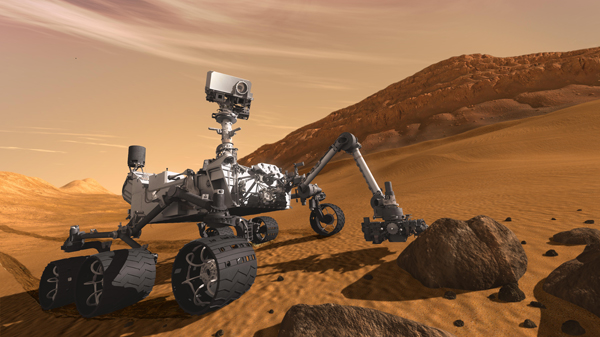 |
| Safely on the surface of Mars, the Curiosity rover begins its long-awaited exploration of the red planet. (Credit: NASA) |
"The actuators got a lot of the press at that point in time, but I think it was much more broad than that," Theisinger said. "I think we felt with the delivery delays we'd had in several areas that we just did not have enough time to complete a good-enough test program to be confident that we had all the risk retired by the time we got to the 2009 launch opportunity."
All of the actuators have now been delivered, and qualification units have completed life cycle testing. The steering and motor actuators needed by Curiosity's wheels and suspension are now in place on the spacecraft. Actuators for the rover's instrument/camera mast have been installed in the mast and those needed by Curiosity's robot arm are undergoing environmental testing.
The spacecraft's critical landing radar, which will feed data to the flight computer during powered descent to the surface, should be delivered in late August, after environmental testing. An engineering model has been tested on a helicopter and will be mounted in an F-18 jet in October for additional trials.
The rover's electronics have been "more of a slog," Theisinger said. Environmental tests of the central computer are under way and the electronics that will control the rover's drive motors have been delivered.
Curiosity's 10 instruments are in various stages of assembly and checkout. One of them, the Sample Analysis at Mars, or SAM, instrument features a gas chromatograph, a mass spectrometer, and a tunable laser to identify carbon-containing compounds. Certification of a 100,000-rpm pump has proved especially difficult, and the instrument is not expected to be delivered until the end of the year.
"I think for the most part, all the flight stuff will be in our hands, with the exception of the SAM instrument, around September or October," Theisinger said. "We are currently scheduled to start the environmental testing on the full-up rover in the third week of February of next year. That'll run a couple of months. Then we ship directly to Florida."